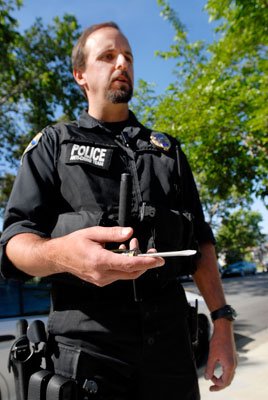If layoffs go through, the city could revert to the crime-ridden
1980s, when gang activity was rampant and residents were fearful to
enter parks, police officers said.
If layoffs go through, the city could revert to the crime-ridden 1980s, when gang activity was rampant and residents were fearful to enter parks, police officers said.
The council plans to lay off 10 sworn officers, which could result in the dissolution
of the police department’s gang unit – a highly trained cadre of six officers who can identify Gilroy’s 750 gang members by name and tattoos, and know where they hang out, who they hang out with, what kind of clothes they wear and which words they say. If this happens, police will lose their grip on this troublesome crowd, 39-year-old Gang Investigator Michael Bolton said.
While none of the department’s 59 sworn officers were laid off last winter, two quit Wednesday, creating a patrol vacuum one of the gang unit’s officers has had to fill. If additional layoffs come, the department would have to redeploy the entire gang unit, Bolton said.
“The common response from gang members in jail who are turning their lives around is, ‘Be careful in Gilroy. The white cars are gonna come for you,'” Bolton said in reference to the white Ford Crown Victorias he and his crew drive instead of the standard black-and-white cruisers. “If these layoffs occur, it’s not going to take long for the gang population to figure out the white cars aren’t there anymore.”
Three white cars arrested a 20-year-old male on probation Thursday morning. Officers awoke the suspected gang member and found knives, letters from known incarcerated gang members, and gang-related clothing, accessories and drawings – all of which violated the terms of his probation.
“Apparently he hasn’t given up that life yet,” Cpl. James Callahan said as his colleagues in bullet-proof vests searched the apartment along Hanna Street before walking the shirtless arrestee to jail less than a block away.
Bolton – an 11-year officer who makes about $100,000 a year, not including benefits, and has been on the gang unit for the past two years – and the five other officers on his team split their time each week among paperwork, undercover surveillance, interviews and overt suppression in their white cars. Since the establishment of the unit in the early 1990s, Gilroy’s violent gang activity has declined from its peak of 454 crimes per year to 229 crimes in 2008. Along with vocal residents and some council members, Bolton fears layoffs will return Gilroy to his teenage years in the late 1980s, when he said families were afraid to visit city parks because of rampant gang activity.
“That team is doing their job and keeping a lid on things as they are now,” Councilman Perry Woodward said.
At Wednesday night’s council meeting, resident and conservative activist Mark Zappa stood up and said, “Nobody’s going to want to come work in Gilroy after (the council) has assassinated 10 officers.” He went on to say that multi-million dollar deficits in restricted city funds – which rely on the general fund in the absence of fees from developers – are ultimately siphoning salary money away from public safety officials.
“We don’t need a new swing set or a new slide, but public safety,” Zappa said, citing park improvements that come from restricted city funds. “Most people, if they had to choose between safety and … Gilroy Gardens, I’m fairly certain they’d choose public safety.”
The city loaned itself $13.2 million in restricted fund money to buy Gilroy Gardens in February 2008 and has since incurred a deficit in that account due to stagnant development.
While patrol officers and detectives, who deal with routine domestic disputes and radio calls all day, can investigate criminal gang cases, they will be hard-pressed to tack on gang charges or testify as gang experts in court because they will not know Gilroy’s gang members like Bolton, who pointed out seemingly indecipherably scrawls on a fence outside a known gang member’s home indicating rival gang members were keeping tabs on him.
“That’s not something you notice right away,” Bolton said.
Details like that go into the units’ 120-plus cases that originated with patrol officers who did not have the street contacts or time to do follow-up investigations. This encyclopedic compendium, tips from reticent confidential informants and regular contact with gang members also help outside law enforcement agencies that sometimes call Gilroy to compare notes.
If word gets out that the gang unit has expired, Bolton said Gilroy’s gangs – who lost 25 guns to police in the last two years – will know they have more room to wander.














